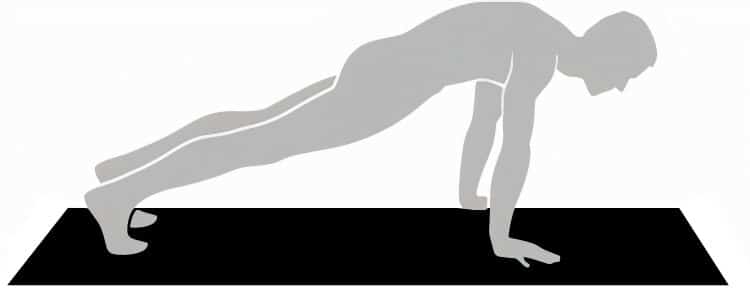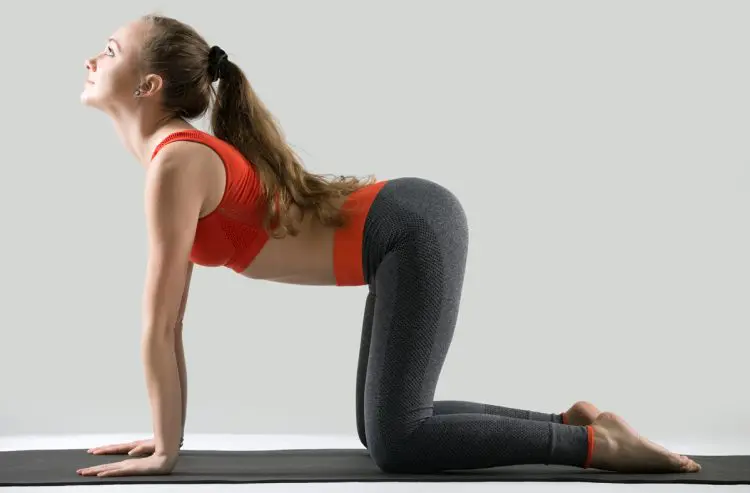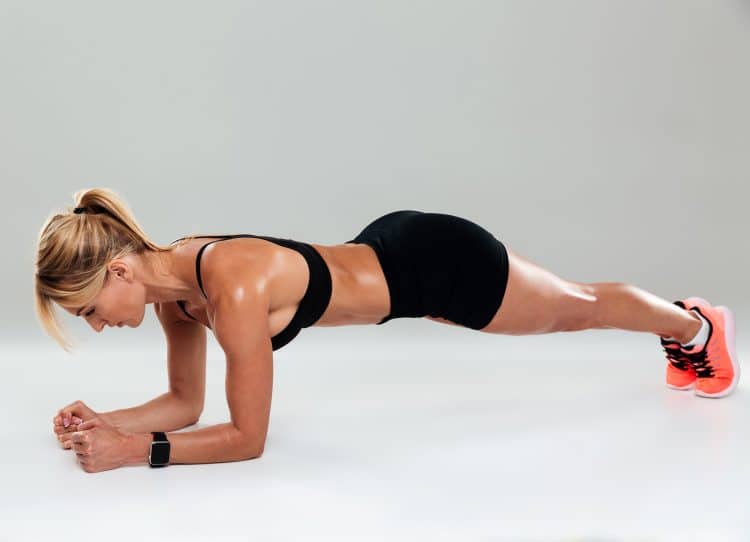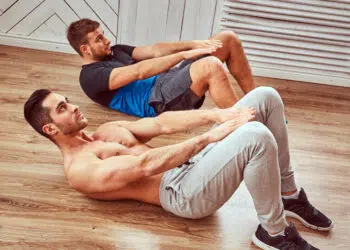A form of isometric exercise, planks are one of the most popular core drills. Isometric exercises involve static muscle contraction without moving any joints.
Like most exercises, planks have drawbacks. One of its cons is often swept under the rug. It is one of the biggest reasons why many trainers skip them in their training regimens. Want to know what it is? (Drumrolls, please) It is boring.
The lifter is not at fault here. After all, the plank makes you stare at the floor for what feels like an eternity. The strain on your core doesn’t help, either.
Adding plank variations like the hollow body plank to your exercise arsenal is one of the best ways to spice up your training regimen. It makes you look forward to your workouts and trains your core from different angles.
The hollow body plank mimics the position of your torso while performing the hollow body hold. The latter requires the exerciser to raise their shoulders, arms, and legs toward the ceiling while lying supine on the floor. But the plank version requires you to assume a high plank position.
Many people tend to cheat on the conventional plank by raising their hips. Exercise experts devised a way to punish these folks, and the hollow body plank was born. Or at least this is what we think happened.
Level Up Your Fitness: Join our 💪 strong community in Fitness Volt Newsletter. Get daily inspiration, expert-backed workouts, nutrition tips, the latest in strength sports, and the support you need to reach your goals. Subscribe for free!
What is a Hollow Body Plank?

The hollow body plank is a plank variation that delivers a better core contraction due to its unique body position. This exercise requires you to hunch your back, which puts your torso in a crunch-like position. The hollow body plank is one of the few occasions where we won’t mind if you round your shoulders and back.
The hollow body plank requires you to get into a high plank position. A high plank position is akin to the push-up starting position. Your hands are under your shoulders, and your toes are tucked in and planted on the floor.
Many find the high plank position more comfortable than the conventional low plank position. The hollow body plank requires you to press your shoulders down and out. In this variation, you’ll experience greater shoulder, pectoral, and arm engagement. Plus, since you’ll be rounding your back, you’ll experience a greater upper back engagement.
Yoga and pilates programs often use the hollow body plank. It can help improve your core strength, stamina, stability, and endurance.
Muscles Worked During Hollow Body Plank
Performing this plank variation engages the following muscles:
Abs
Rectus abdominis, obliques, and transverse abdominis are the primary muscles used during a plank. The rectus abdominis, also known as the abs, is visible when you have a low body fat percentage. [1]
The transverse abdominis is the deepest of the six abdominal muscles. They give your abdomen shape and help stabilize your back. Finally, obliques are fish gill-like muscles on the sides of the rectus abdominis. They help stabilize your core and hold ribs and hips in alignment.
Shoulders
Since the hollow body plank requires you to push out your shoulders, it results in greater anterior, medial, and posterior deltoid engagement than the conventional high plank. You can achieve better delt engagement by actively contracting these muscles.
Chest
The hollow body plank’s forward shoulder and rounded back position results in better pectoral stimulation than the orthodox plank. Place your hands closer than shoulder-width apart for a greater chest engagement.
Arms
While performing the hollow body plank, ensure that your elbow pits are facing forward. This position will fire up your bis and tris. But don’t contract your upper arm muscles during this exercise, as it might lessen the load on your core.
Upper Back
The hollow body plank engages your trapezius, teres major and minor, rhomboid major and minor, and latissimus dorsi. The rounded back position engages each muscle in your back. [2]
Lower Body
Planks need you to balance yourself on your toes. You should flex your quads and glutes to improve your stability. Plus, your hamstrings help with hip flexion during a plank, allowing you to maintain your body in a straight line from your trunk to your legs.
Benefits of a Hollow Body Plank
The plank and hollow body plank share many benefits. Given below are the advantages of adding the isometric exercise into your training regimen:
1. Improves Core Strength
Planks are an isometric exercise that requires you to hold your body in a given position for a prolonged period. Static contractions can improve your core strength and endurance. [3]
2. Strengthens Your Back, Arms, and Shoulders
The hollow body plank is a unique plank variation in that it requires you to round your back, internally rotate your elbows, and push out your shoulders. This setup results in a more significant back, arm, and shoulder engagement than the conventional plank variation.
3. It Might Help Reduce Lower Back Pain
Your abominable muscles support your lumbar spine and provide structural stability. Plus, they help with pelvic movement. Increasing lumbar spine stability can reduce and prevent lower back pain. Studies have shown that a strong core can help reduce lower back pain and the risk of injury. [4]
4. Improves Posture
The hollow body plank can help improve your spinal alignment. This exercise strengthens your back, chest, shoulders, neck, and abs, which can help you maintain an upright posture while sitting or standing.
5. Enhanced Functionality
The hollow body plank is an isometric core exercise. Your core is connected to your lower and upper body and can influence your functionality and performance. A strong core can boost your power output, running performance, and upper body rotation. [5]
How To Do a Hollow Body Plank
This is how to perform the hollow body plank using the perfect form:
Steps:
- Get into a high plank position. Your wrists should be under your shoulders, and your toes flexed and planted on the floor together.
- Spread your fingers for better balance.
- Slowly round your back and lift it toward the ceiling.
- Tuck in your tailbone and contract your abs, glutes, and quads.
- Keep your head neutral.
- Hold the position for as long as possible.
Pro Tips:
- Push your shoulders down to reduce delt engagement.
- Your elbow pits should be facing forward during the exercise.
- Although this exercise involves multiple muscle groups, this is primarily a core exercise.
- You can make the exercise harder by lifting one foot off the floor.
- For advanced lifters only: Use a dip belt to add resistance. It will make the exercise harder and leave you with a nasty pump.
- Ask your training partner to check your form and inform you when your back starts to drop.
This Exercise:
- Target Muscle Group: Abs
- Secondary Muscles: Upper Back, Arms, Shoulders
- Type: Strength
- Mechanics: Isolation
- Equipment: Bodyweight
- Difficulty: Beginner
- Best Time: 60-120 seconds
Read also: Add a new challenging dimension to your core workouts with hollow holds.
Common Mistakes While Performing Hollow Body Plank
Some of the most recurrent hollow body plank mistakes include:
1. Letting Your Back Drop
While you should not arch your back while performing the conventional planks, the opposite rings true for the hollow body plank. The hollow body plank rounded back position lets you better contract your core.
Level Up Your Fitness: Join our 💪 strong community in Fitness Volt Newsletter. Get daily inspiration, expert-backed workouts, nutrition tips, the latest in strength sports, and the support you need to reach your goals. Subscribe for free!
2. Pulling Back Your Shoulders
Many tend to relax their delts during the exercise by pulling back their shoulder blades. However, doing this will mess with your back arch. Keep your shoulder pushed forward throughout this plank variation.
3. Raising Your Hips
Do not confuse this exercise with the downward-facing dog. Lifting your hips toward the ceiling will remove tension from your core and put it on your posterior chain. Tuck in your tailbone while doing the hollow body plank.
4. Looking Ahead
Pointing the crown of your head toward the floor or looking at the wall in front of you while doing the hollow body plank can put unnecessary strain on your neck. Maintain a neutral head position to avoid neck pain.
5. Bending Your Knees
While it is okay to maintain a slight knee bend during this exercise, excessively bending your knees will pull your hips toward the floor and remove tension from your core.
Variations and Alternatives of Hollow Body Plank
Add these hollow body plank variations and alternatives to your training arsenal:
1. Cat Pose
We recommend starting with the cat pose if you are a beginner and cannot hold a high plank position. Marjaryasana is a yoga pose that looks like a hollow body plank with your knees under your hips. This setup can reduce the tension on your core.

Steps:
- Start in a tabletop position with your hands under your shoulders and your knees under your hips.
- Press your palms into the floor and round your back. Pull your belly button into your spine.
- Push your shoulders out and down.
- Drop your tailbone and head toward the floor.
- Hold the position for 60-120 seconds. Contract your core as hard as you can.
Pro Tip: Keep your head neutral while performing this exercise. Bending your neck down or looking up can strain your back.
Check out our complete cat stretch guide here!
2. Plank
The conventional plank is great for beginners. You should always master an exercise because moving on to its variations.

Steps:
- Kneel on an exercise mat.
- Lower yourself into a low plank position by placing your forearms on the floor at shoulder width. Your forearms should be parallel to each other. Extend your legs behind you.
- Ensure that your body is in a straight line from head to toe.
- Contract your core and glutes.
- Hold this position for as long as possible.
Pro Tip: Depending on your experience level, you could also try the high plank.
Check out our complete plank guide here!
3. Plank Thrust
Plank thrust is an advanced plank variation that will smoke your abs. This exercise is recommended for intermediate to advanced lifters with decent core strength.
Steps:
- Get into a low plank position.
- Your body should be in a straight line from head to toe at the start position.
- Contract your core and glutes.
- Raise your glutes toward the ceiling.
- Reverse the motion and lower your glutes toward the floor until your groin is a few inches away.
- Repeat this motion for the recommended reps.
Pro Tip: Do not extend your legs fully for this variation, as it will limit your range of motion while lifting your butt.
4. Plank with Shoulder Tap
This plank variation results in greater shoulder and core recruitment as you must balance your body on one arm for a good part of this exercise.
Steps:
- Start in a high plank position.
- Place your feet wider than shoulder-width apart for better stability.
- Keeping your core tight, lift your right hand off the floor and touch your left shoulder.
- Return to the starting position.
- Repeat with your left hand.
- Alternate between sides for recommended reps.
Pro Tip: Ensure that your shoulders and chest are square throughout the exercise. Bending on one side removes the tension from your core and puts it on your shoulder.
5. Mountain Climber
The mountain climber is a great core exercise for beginners who cannot hold a plank and contract their core and glutes for the recommended time.
Steps:
- Get into a high plank position.
- Keeping your core and glutes engaged, lift your right foot off the floor and bring your right knee toward your chest.
- Avoid rotating your hips or shoulders.
- Return to the starting position.
- Repeat on the left side.
- Alternate between sides for recommended reps or time.
Pro Tip: Increase your speed as you get better at this exercise.
Check out our complete mountain climber guide here!
FAQs
Is a hollow body plank better than a conventional high plank?
Many consider the hollow body plank an advanced variation of the conventional high plank. One cannot objectively compare both these exercises and pick a winner. Both deserve a place in your training regimen, and you should alternate between the two to add variety to your training session.
How many calories do planks burn?
The calories burned while planking depends on your body weight, age, and the plank duration. A 150-pound trainer typically burns about 3-4 calories a minute while holding a plank.
Wrapping Up
The hollow body plank is an underutilized plank variation that fires up your upper and lower body. To put it in other words, it unleashes the hidden potential of the plank. It offers more benefits than the conventional high plank due to its unique setup. Perfecting this isometric exercise might take some practice. Add the hollow body plank to your training regimen if you are bored with the orthodox plank.
References
- Oliva-Lozano JM, Muyor JM. Core Muscle Activity During Physical Fitness Exercises: A Systematic Review. Int J Environ Res Public Health. 2020 Jun 16;17(12):4306. doi: 10.3390/ijerph17124306. PMID: 32560185; PMCID: PMC7345922.
- Youdas JW, Coleman KC, Holstad EE, Long SD, Veldkamp NL, Hollman JH. Magnitudes of muscle activation of spine stabilizers in healthy adults during prone on elbow planking exercises with and without a fitness ball. Physiother Theory Pract. 2018 Mar;34(3):212-222. doi: 10.1080/09593985.2017.1377792. Epub 2017 Sep 18. PMID: 28922049.
- Hung KC, Chung HW, Yu CC, Lai HC, Sun FH. Effects of 8-week core training on core endurance and running economy. PLoS One. 2019 Mar 8;14(3):e0213158. doi: 10.1371/journal.pone.0213158. PMID: 30849105; PMCID: PMC6407754.
- Choi JH, Kim DE, Cynn HS. Comparison of Trunk Muscle Activity Between Traditional Plank Exercise and Plank Exercise With Isometric Contraction of Ankle Muscles in Subjects With Chronic Low Back Pain. J Strength Cond Res. 2021 Sep 1;35(9):2407-2413. doi: 10.1519/JSC.0000000000003188. PMID: 31136542.
- Santos MS, Behm DG, Barbado D, DeSantana JM, Da Silva-Grigoletto ME. Core Endurance Relationships With Athletic and Functional Performance in Inactive People. Front Physiol. 2019 Dec 18;10:1490. doi: 10.3389/fphys.2019.01490. PMID: 31920697; PMCID: PMC6930174.
Interested in measuring your progress? Check out our strength standards for Mountain Climbers.








